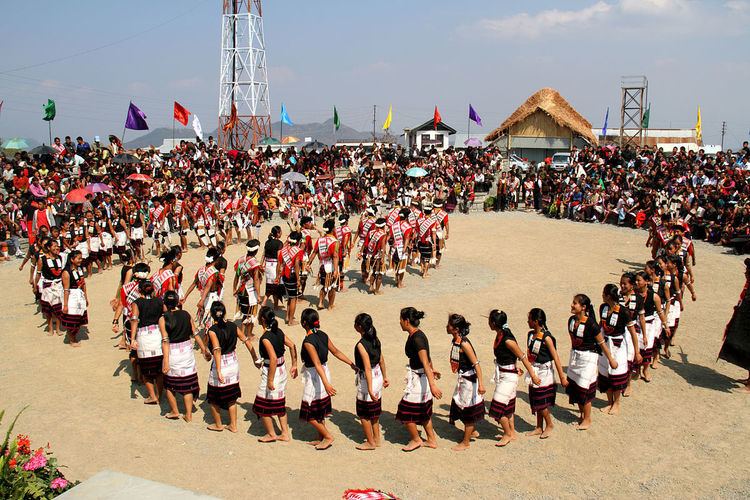 | ||
Main Bhi Bharat - The Angami Naga Tribe of Nagaland
The Angamis are a major Naga tribe native to Nagaland state in North-East India. They are listed as a Scheduled Tribe, in the 5th schedule of the Indian Constitution. They are known for the Sekrenyi celebrations every February.
Contents
- Main Bhi Bharat The Angami Naga Tribe of Nagaland
- Division
- Culture and religion
- Sekrenyi
- Famous people
- References
Division
The territory of the Angamis is made up of the present Kohima district, which is divided into four regions:
The former Eastern Angami have separated and are now recognised as Chakhesang.
Culture and religion

The Angami Nagas are hill people depending basically on cultivation and livestock-rearing. The Angamis are known for terraced wet-rice cultivation; because of this labor-intensive cultivation, land is the most important form of property among them. They are one of the only two groups of Nagas out of the seventeen who practice wet-rice cultivation on terraces made on the hill slopes. This allows them to cultivate the same plot year after year. They depend, to a very small extent, on slash-and-burn cultivation.
Angamis were traditionally warriors. The Angami men spent the majority of their time in warfare with hostile villages and taking heads. Since 1879, when the British succeeded in annexing their territory, the inter-village feuds have come to an end. With the introduction of Christianity in the region several Angamis changed their faith to Christianity.
Social stratification is not observed in the Angami community. Traditionally, property was divided equally among sons with daughters also receiving a share; in modern families it is shared among children. The youngest male in the family inherits the parental home, Kithoki, which means he is responsible for their care until they pass away.
The Angami Christians are composed of five major denominations: Baptist, Christian Revival, Roman Catholic, Pentecostal and Seventh-day Adventist. Baptists constitute more than 80% of the total Angami Christian population and all the Baptist churches in their region are under the Angami Baptist Church Council.
Although more than 98% of the Angamis are Christians, they are one of the last Naga tribes having an animist population. The Angami animists practice a religion known as Pfutsana. According to the 1991 census, there were 1,760 Angami practitioners, but 10 years later the figure had halved to 884. Currently there are several hundred adherents of the Pfutsana religion, scattered in nine villages of the southern Kohima district. A religious organization, 'Japfuphiki Pfutsana', was founded in 1987 to streamline indigenous religious practices among the Angamis.
Sekrenyi
The Angamis celebrate a ten-day festival called Sekrenyi (sometimes also called Phousanyi) in February. The term Sekrenyi literally means sanctification festival (sekre = sanctification; nyi = feast; thenyi = festival). The festival takes places after the harvest and falls on the twenty-fifth day of the month Kezei (January–February).
The festival follows a circle of ritual and ceremony, the first being kizie. A few drops of rice water taken from the top of a type of jug called zumho are put on leaves. These are placed at the three main posts of the house by the lady of the household. On the first day, the young and old go to the village well to bathe.
In the night, two young men clean the well. Some of the village youth guard the well, as no one is allowed to fetch water after the cleaning. As women are especially not allowed to touch the well water at this time, they must make sure that water is fetched for the household before then. Early next morning, all the young men of the village attend the washing ritual. They wear two new shawls (the white Mhoushü and the black Lohe) and sprinkle water on their chests, knees, and right arms. This ceremony is called dzüseva ('touching the sleeping water'); in it, the well water symbolically washes away all their ills and misfortunes.
On their return from the well, a rooster is sacrificed. It is taken as a good omen when the right leg falls over the left leg as it falls down. The innards of the rooster are then hung outside the house for the village elders to inspect. A three-day session of singing and feasting starts on the fourth day of the festival.
The most interesting part is the thekra hie. The thekra hie is when the young people of the village sit together and sing traditional songs throughout the day. Jugs of rice beer and plates of meat are placed before the participants. On the seventh day, the young men go hunting. The most important ceremony falls on the eighth day when the bridge-pulling, or gate-pulling, is performed and inter-village visits are exchanged. All field work ceases during this season of feasting and song.
Famous people
The following is a list of prominent people belonging to the Angami :tribe:
